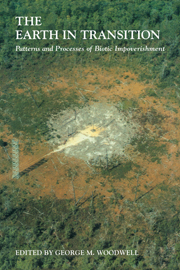Book contents
- Frontmatter
- Contents
- Preface
- Acknowledgments
- List of Contributors
- Part I Global Change and the Patterns of Impoverishment
- Part II Chronic Disturbance and Natural Ecosystems: Forests
- Part III Chronic Disturbance and Natural Ecosystems: Woodlands, Grasslands, and Tundra
- 14 Changes in the Mediterranean Vegetation of Israel in Response to Human Habitation and Land Use
- 15 Bromus tectorum, a Biotic Cause of Ecosystem Impoverishment in the Great Basin
- 16 Detecting Early Signs of Regional Air-Pollution Injury to Coastal Sage Scrub
- 17 Arctic Ecosystems: Patterns of Change in Response to Disturbance
- Part IV Chronic Disturbance and Natural Ecosystems: Aquatic and Emergent Ecosystems
- Part V Conclusion: Steps toward a World That Runs Itself
- Name Index
- Subject Index
17 - Arctic Ecosystems: Patterns of Change in Response to Disturbance
Published online by Cambridge University Press: 24 November 2009
- Frontmatter
- Contents
- Preface
- Acknowledgments
- List of Contributors
- Part I Global Change and the Patterns of Impoverishment
- Part II Chronic Disturbance and Natural Ecosystems: Forests
- Part III Chronic Disturbance and Natural Ecosystems: Woodlands, Grasslands, and Tundra
- 14 Changes in the Mediterranean Vegetation of Israel in Response to Human Habitation and Land Use
- 15 Bromus tectorum, a Biotic Cause of Ecosystem Impoverishment in the Great Basin
- 16 Detecting Early Signs of Regional Air-Pollution Injury to Coastal Sage Scrub
- 17 Arctic Ecosystems: Patterns of Change in Response to Disturbance
- Part IV Chronic Disturbance and Natural Ecosystems: Aquatic and Emergent Ecosystems
- Part V Conclusion: Steps toward a World That Runs Itself
- Name Index
- Subject Index
Summary
Editor's Note: The Arctic with its limited flora and fauna, its extremes of climate, its indigenous people, its ties to montane habitats of lower latitudes, and its uncertain history has always captured the interest of ecologists. The landscape, despite the vicissitudes of climate and the long months of darkness and frost, is a living landscape, a tightly integrated community, not open to easy invasion by exotics, its living systems strangely immune to disease. It is vulnerable, but disruption, when it comes, can be severe: “thermal karst erosion” is the phrase the specialists use to describe the destruction that occurs as the surface albedo drops and the sun melts the ground that is usually frozen. A trickle of water becomes an erosive force, transforming the tundra into a slurry of mud and eroding peat.
Efforts at stabilizing landscapes disturbed by human activities, building plant successions where none exists, have met with limited success. Massive efforts at introducing exotics have, fortunately, failed. The arctic ecosystems are closed corporations, not open to outsiders. Bliss shows that plant succession as recognized in lower-latitude communities is weakly developed, in some circumstances non-existent. But the communities are surprisingly resilient … to the point where the erosion starts. Once it starts, there is no cure in time of interest to this generation … or the next.
Bliss, who has devoted a career to the Arctic, has written comprehensively and sensitively about arctic ecosystems. He sees no mitigating circumstance in a rapid warming and no effective countermeasure.
- Type
- Chapter
- Information
- The Earth in TransitionPatterns and Processes of Biotic Impoverishment, pp. 347 - 366Publisher: Cambridge University PressPrint publication year: 1991
- 1
- Cited by



